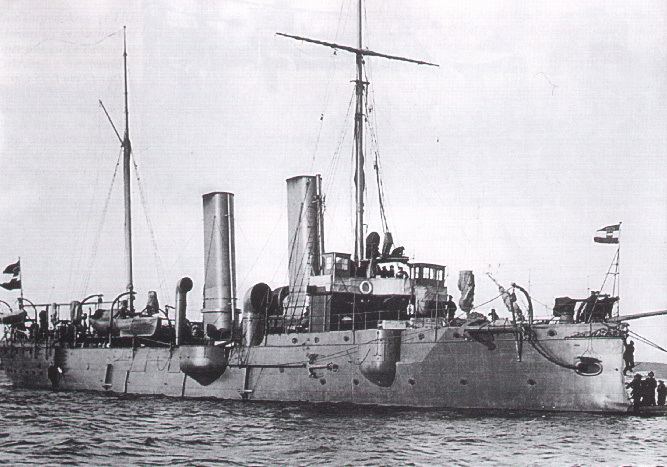Name SMS Panther Completed 31 December 1885 Launched 13 June 1885 | Laid down 29 October 1884 Fate Broken up, 1920 Construction started 29 October 1884 Length 73 m | |
 | ||
Displacement 1,557 t (1,532 long tons; 1,716 short tons) | ||
SMS Panther was a torpedo cruiser (Torpedoschiff) of the Austro-Hungarian Navy. She and her sister ship, Leopard were part of a program to build up Austria-Hungary's fleet of torpedo craft in the 1880s. She was the lead ship of her class, and was built in Britain by Armstrong, from her keel laying in October 1884 to her completion in December 1885. She was armed with a battery of two 12 cm (4.7 in) guns and ten 47 mm (1.9 in) guns, along with four 356 mm (14.0 in) torpedo tubes.
Contents
After arriving in Austria-Hungary, Panther initially served with the main fleet. During this period, she visited Spain for the 1888 Barcelona Universal Exposition. Starting in the mid-1890s, the ship spent much of her time abroad. From 1896 to 1898, she was stationed in China, and she sent a shore party to help United States Marines protect US civilians during a riot. She went on a cruise in the Mediterranean in 1902, and in 1905, she visited East Africa. Panther was modernized in 1909–1910 and received a new gun armament. At the outbreak of World War I in July 1914, the ship was assigned to the Coastal Defense Special Group; these ships provided artillery support to an Austro-Hungarian Army attack in January 1916 that knocked Montenegro out of the war. The next year, Panther was withdrawn from frontline service and employed as a training ship. Awarded to Britain in the postwar division of war prizes, Panther was broken up for scrap in Italy in 1920.
Design
Panther was 73.19 meters (240 ft 1 in) long overall, with a beam of 10.39 m (34 ft 1 in) and a draft of 4.28 m (14 ft 1 in). She displaced 1,557 t (1,532 long tons; 1,716 short tons). The ship's propulsion system consisted of a pair of two-cylinder vertical compound steam engines. On trials, Panther reached a speed of 18.4 knots (34.1 km/h; 21.2 mph) from 5,940 indicated horsepower (4,430 kW), slightly slower than her sister ship Leopard. Her crew numbered 186 officers and men.
The ship was armed with two 12-centimeter (4.7 in) 35-caliber (cal.) guns manufactured by Krupp in single mounts. These were supported by a battery of four 47 mm (1.9 in) quick-firing guns and six 47 mm revolver cannon. She was also armed with four 356 mm (14.0 in) torpedo tubes. The torpedo tubes were located singly, in the bow, stern, and at either beam. Panther was protected with a thin 12 mm (0.47 in) armored deck.
Service
Panther was built in Britain by the Armstrong shipyard in Elswick. Her keel was laid down on 29 October 1884, and her completed hull was launched on 13 June 1885. She was completed on 31 December 1885. She participated in the annual fleet maneuvers in 1888, along with the ironclads Don Juan d'Austria, Kaiser Max, Custoza, Tegetthoff, and the cruisers Leopard and Meteor. That year, Panther and Leopard joined a squadron that included the ironclads Tegetthoff, Custoza, Kaiser Max, Don Juan d'Austria, and Prinz Eugen to represent Austria-Hungary in the opening ceremonies for the Barcelona Universal Exposition. This was the largest squadron of the Austro-Hungarian Navy that had operated outside the Adriatic.
From 1896 to 1898, Panther was deployed to the East Asian station. During this period, she assisted American Marines from the gunboat USS Monocacy in Shanghai. The Austro-Hungarian landing party Panther sent ashore helped the Marines protect American civilians during riots in the area. Panther returned home in 1898 after having been relieved by the old corvettes Saida and Frundsberg. In 1902, Panther cruised the western Mediterranean Sea and briefly into the Atlantic Ocean, making a call in Morocco. The ship went to East Africa in 1905, under the command of Captain Ludwig von Höhnel. The ship stopped in French-controlled Djibouti, where Höhnel and a group left the ship to travel overland to Ethiopia, where they concluded a trading treaty for Austria-Hungary. In June 1909, the ship was drydocked for modernization that included a complete overhaul of her gun battery; after emerging from the shipyard, she carried four 66 mm (2.6 in) 45-cal. guns and ten 47 mm QF guns, along with her original torpedo tubes.
At the outbreak of World War I in July 1914, Panther was assigned to the Coastal Defense Special Group, along with the three Monarch-class coastal defense ships and the cruiser Kaiser Franz Joseph I. The ships were commanded by Rear Admiral Richard von Barry. From 8 to 10 January 1916, Panther and the ships of the Coastal Defense Special Group provided artillery support to the troops of the XIX Corps as they mounted a major attack to destroy Montenegrin forces from Mount Lovcen. The success of the offensive forced Montenegro out of the war shortly thereafter. Later that year, she had one of her 66 mm guns replaced with a 66 mm gun in an anti-aircraft mounting. From 1917, she was employed as a training ship for the Submarine Commander's School in Cattaro Bay. Under the terms of the Treaty of Saint-Germain-en-Laye, Britain received Panther as a war prize in 1920, but she was instead sold to ship breakers in Italy and scrapped in 1920.
